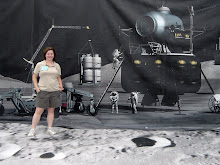In just about six weeks, I'll be joining my second season with the Antarctic Search for Meteorites (ANSMET). I'm so excited! This year, I'll be on the reconnaissance team, scouting new icefields in the Transantarctic Mountains to see if any of them have a concentration of meteorites. It means I'll get to see a lot more scenery than the flat ice field where I spent last season! I'll be helping to maintain a web log of our activities, including sending some live data back from the field.
Why do we go to Antarctica to get meteorites? Meteorites fall randomly over the whole Earth throughout time. But, if a meteorite falls in the ocean, or fell 10,000 years ago, it's unlikely anyone's ever going to find it now. Once a meteorite lands, the Earth's forces of water and biology start breaking it down. There are some places on the Earth that are good for finding meteorites when there is a mechanism for concentrating many years' worth of falls in one spot and storing them under very dry conditions. The hot deserts are good for this, where meteorites land among the sand dunes and then when the wind shifts and starts blowing sand away, the meteorites are exhumed. Antarctica is also a good place because meteorites that fall on the glaciers get entrained in the ice (which is actually a pretty dry environment because the ice is so cold it never melts) and carried along the conveyor belt of the glacier. When the glacier runs up against a mountain, the winds convert the ice directly into the vapor phase (like leaving ice cubes too long in your freezer) and the meteorites are left behind. The ANSMET program has recovered more than 25,000 meteorites, or 85% of the world’s meteorite collection.
Why do we study meteorites? The basis of geology is that rocks hold information about the formation and evolution of their parent planet. On the Earth, we can hike around, study rocks in the field, and bring them to the lab for detailed analysis. But we've only collected rocks from only one other planetary field site, the Moon. So meteorites are especially scientifically valuable because they are the only rocks we have from Mars and the asteroids. Even lunar meteorites come from places on the Moon where human have never been and never sampled, and have given us a whole new view of lunar rocks. Remote-sensing techniques, like the spectrometers on our rover friends, are good at what they do but are still a far cry from being able to pick up a rock, crack it open, and measure its isotopic composition to, say, 1% accuracy.
Here's lots more about the scientific importance of meteorites, along with details on how they are collected and curated.
What's an ANSMET season like? You can check out last year's team blog or Linda's PSRD article written after the 2002 season. And, of course, you should tune in to my ANSMET blog to find out this year!
Subscribe to:
Post Comments (Atom)

2 comments:
Riddle me this Science Girl...
Do you need some special skill to hunt meteorites? I mean can you outline a little training program for the average guys like me?
I travel quite extensively, all over the world. Most times I find myself in remote locations. Perhaps I have walked right by one and never noticed.
I saw in one of the blogs from the South Pole that they have kind of a baked shell to them.
So fill us in. For those of us who can't join the cool South Pole expedition, aren't planetary scientists or geologists but who would still like to hold a piece of something that fell from space.
Where do we start? What tools do we need? You and your friends make Meteorite hunting seem fun and interesting. How can "we" do it and what should be do with the meteorites that we find?
I don't mean to put pressure on you but, a highly detailed process with a lot of pictures would be helpful. Especially pictures with circles and arrows and a paragraph explaining what each one is about…
Thanks in advance...
Post a Comment